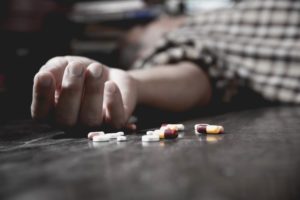Overdose death rates have risen sharply in the last twenty years, with over 100 people in the U.S. dying every day from drug overdoses. Many drug overdoses are accidental, while a portion is attempted suicides. The rise in drug overdose death rates has also impacted the U.S. life expectancy rate, lowering it by several years, and accidental overdose deaths are the leading cause of death in people under the age of 50. Opioid-derivative drugs are the biggest culprits behind the rise in overdose deaths, with about 130 people dying every day in the U.S. from opioid overdoses. Accidental overdoses are reversible if the signs are noticed quickly enough, and patients can receive swift medical attention.
What is an overdose, and how does it happen?
An overdose is when a person takes more of a substance than their body can process. The toxicity threshold for substances is different for everyone. Plus, some drugs are more toxic than others. When someone takes a dose of a substance, their body’s metabolism may not be able to detoxify their system fast enough to avoid potentially life-threatening symptoms. Essentially, a drug overdose is akin to poisoning.
Drug overdoses can be accidental or intentional. Most overdoses are unintentional, and people can overdose from illegal substances, prescription medications, alcohol, or a combination of these substances. Every drug overdose is different, and treatment methods must be tailored to the individual patient and the type of substance they’ve overdosed on. Many overdoses can be reversed with certain drugs such as Narcan.
What are the current statistics on drug overdoses in the U.S.?
According to the CDC, drug overdoses rose sharply from 1999 to 2017. Within that time frame, more than 700,000 people in the U.S. died from drug overdoses. In 2017, the CDC found that both legal and illegal opioids caused 68% of drug overdose deaths. Studies on overdoses have found that the most common drugs found in accidental drug overdose deaths were Fentanyl, heroin, and cocaine. In drug overdose suicides, oxycodone, diphenhydramine, hydrocodone, and alprazolam were the most commonly used drugs. Overdoses can happen when someone uses drugs for the first time, and overdose deaths tend to occur within the first one to three hours after someone takes drugs.
Who is most at risk of overdosing on drugs?
People between the ages of 25 and 64 are more at risk of dying from a drug overdose than of dying in a motor vehicle accident – one of the leading causes of death for this age group. Mixing different substances, and mixing drugs with alcohol significantly increases a person’s risk of overdose. Some of the most deadly drug combinations for overdose include mixing opioids with other depressants like alcohol, or benzodiazepines.
People who achieve sobriety from opioids and then go on to relapse are at increased risk of accidentally overdosing on these drugs. After a period of abstinence from these drugs, the body quickly loses its tolerance to opioids. But the reverse is also true. The body quickly develops a tolerance to opioid medications. Someone who has abused opioids long-term or severely, quits, and then relapses, may accidentally take too many opioids thinking they still possess the same level of tolerance they had during the peak of their addiction. This process may explain why opioid overdoses are the leading cause of drug overdose deaths in the U.S.
When someone mixes heroin with a powerful prescription opioid such as Fentanyl or combines heroin with cocaine, this process is called “speedballing” and significantly increases the risk of overdose. People who are addicted to heroin are at high-risk of overdosing because it is impossible for someone to know if the heroin has been cut or otherwise diluted with something like sugar or baby formula. Someone who has only had cut heroin may end up with a strong, pure batch and accidentally overdose.
Smoking, asthma, and upper respiratory infections can also increase the risk of overdose since these factors all limit the amount of oxygen a person gets into their bloodstream. Taking a powerful central nervous system depressant like Fentanyl or heroin can increase the chances of an overdose in these cases. People who take numerous prescription medications are also at risk of accidental overdose. They may forget that they’ve already taken their medication and unintentionally give themselves a second dose.
What are the signs of a drug overdose?
Different drugs or mixtures of dangerous substances will show slight variations in early overdose symptoms. Since most people who overdose die within the first one to three hours after taking a dangerous level of drugs, it’s imperative that they get help quickly once symptoms manifest.
Some of the most common symptoms of overdose include:

